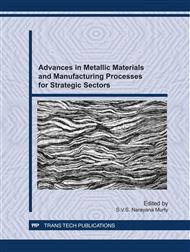[1]
A. Belyakov, T. Sakai, H. Miura, R. Kaibyshev, Substructures and internal stresses developed under warm severe deformation of austenitic stainless steel, Scripta Mater. 42 (2000) 319-325.
DOI: 10.1016/s1359-6462(99)00353-x
Google Scholar
[2]
R.Z. Valiev, Structure and Mechanical Properties of Ultrafine grained material, Mater. Sci. Eng. A 234-236 (1997) 59-66.
Google Scholar
[3]
P.Q. La, J.Q. Ma , Y.T. Zhu , J. Yang, W. Liu, Q. Xue, R. Valiev, Dry-sliding tribological properties of ultrafine-grained Ti prepared by severe plastic deformation, Acta Mater. 53 (2005) 5167-73.
DOI: 10.1016/j.actamat.2005.07.031
Google Scholar
[4]
Y. S. Kim, T. Lee, K.T. Park, W.J. Kim, D.H Shin, Dry sliding wear behavior of ultrafine grained commercial purity aluminum and low carbon steel produced by severe plastic deformation techniques, UFG Materials II. Symp. Proc., 2002 TMS annual meeting.
DOI: 10.1002/9781118804537.ch47
Google Scholar
[5]
Y. S. Kim, J.S. Ha, D. H. Shin, Sliding wear characteristics of ultrafine grained non strain hardening aluminum-magnesium alloy, Mat. Sci. Forum 475- 479 (2005) 401-404
DOI: 10.4028/www.scientific.net/msf.475-479.401
Google Scholar
[6]
L. Gao and X. Cheng: Microstructure and dry sliding wear behavior of Cu–10%Al–4%Fe alloy produced by equal channel angular extrusion, Wear 265-7-8 (2008) 986-991.
DOI: 10.1016/j.wear.2008.02.014
Google Scholar
[7]
H. Garbacz , M. Gradzka-Dahlke and K. Kurzydłowski, The tribological properties of nano-titanium obtained by hydrostatic extrusion, Wear 263 (2007) 572–578
DOI: 10.1016/j.wear.2006.11.047
Google Scholar
[8]
G. Purcek, O. Saray, O. Kul, I. Karaman, G. Yapici, M. Haouaoui, H. Maier, Mechanical and wear properties of ultrafine-grained pure Ti produced by multi-pass equal-channel angular extrusion, Mater. Sci. Eng. A 517 (2009) 97-104.
DOI: 10.1016/j.msea.2009.03.054
Google Scholar
[9]
A. Kluge, K. Langguth, R. Ochsner, K. Kobs, H. Ryssel, Examination of Wear, Hardness and Friction of Nitrogen-, Boron-, Carbon-, Silver-, Lead- and Tin-implanted Steels with Different Chromium Contents, Mater. Sci. Eng. A 115(1989) 261-265.
DOI: 10.1016/0921-5093(89)90688-6
Google Scholar
[10]
A.K. Padap, G.P. Chaudhari, S.K. Nath, V. Pancholi, Ultrafine-grained steel fabricated using warm multiaxial forging: microstructure and mechanical properties, Mater. Sci. Eng. A 527 (2009)110.
DOI: 10.1016/j.msea.2009.08.066
Google Scholar
[11]
M.K. Chung, Y.S. Choi, J.G. Kim, Y.M. Kim, J.C. Lee, Effect of the number of ECAP pass time on the electrochemical properties of 1050 Al alloys, Mater. Sci. Eng. A 366 (2004) 282-291.
DOI: 10.1016/j.msea.2003.08.056
Google Scholar
[12]
A. Balyanov, J. Kutnyakova, N.A. Amirkhanova, V.V. Stolyarov, R.Z. Valiev, X.Z. Liao, Y.H. Zhao, Y.B. Jiang, H.F. Xu, T.C. Lowe, Y.T. Zhu, Corrosion resistance of ultra fine-grained Ti., Scripta Mater. 51(2004) 225-229.
DOI: 10.1016/j.scriptamat.2004.04.011
Google Scholar
[13]
W. Wei, K.X. Wei, Q.B. Du, Corrosion and tensile behaviors of ultra-fine grained Al-Mn alloy produced by accumulative roll bonding, Mater. Sci. Eng. A 454-455(2007) 536-541.
DOI: 10.1016/j.msea.2006.11.063
Google Scholar
[14]
G. B. Hamu, D. Eliezer, L. Wagner, The relation between severe plastic deformation microstructure and corrosion behavior of AZ31 magnesium alloy, J. Alloys Compd. 468 (2009) 222-229.
DOI: 10.1016/j.jallcom.2008.01.084
Google Scholar
[15]
S.M. Lim, M. E. Wahabi, C. Desrayaud, F. Montheillet, The refinement of grain structure in a high-purity α-iron base alloy under multiaxial compression, Adv. Mater. Res. 5-17 (2007) 900-905.
DOI: 10.4028/www.scientific.net/amr.15-17.900
Google Scholar
[16]
T.H. Hyde, W. Sun, J. A. Williams, Requirements for and use of miniature test specimens, Int. Mater. Rev. 52 (2007) 213-255.
Google Scholar
[17]
B. Bhushan, Introduction to Tribology, John Wiley, New York, (2002).
Google Scholar


